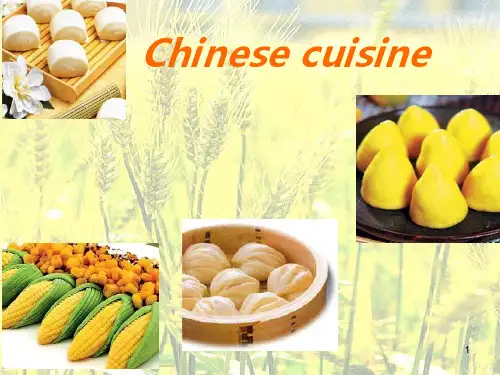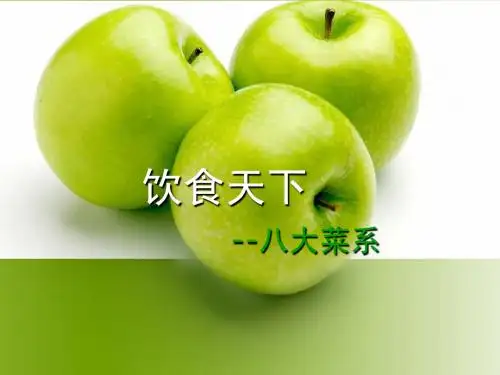湘菜英文介绍ppt
- 格式:ppt
- 大小:2.90 MB
- 文档页数:8
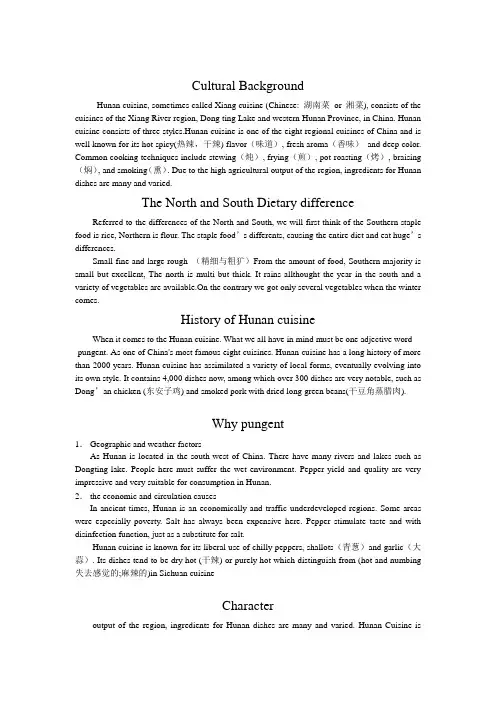
Cultural BackgroundHunan cuisine, sometimes called Xiang cuisine (Chinese: 湖南菜or 湘菜), consists of the cuisines of the Xiang River region, Dong ting Lake and western Hunan Province, in China. Hunan cuisine consists of three styles.Hunan cuisine is one of the eight regional cuisines of China and is well known for its hot spicy(热辣,干辣) flavor(味道), fresh aroma(香味)and deep color. Common cooking techniques include stewing(炖), frying(煎), pot-roasting(烤), braising (焖), and smoking(熏). Due to the high agricultural output of the region, ingredients for Hunan dishes are many and varied.The North and South Dietary differenceReferred to the differences of the North and South, we will first think of the Southern staple food is rice, Northern is flour. The staple food’s differents, causing the entire diet and eat huge’s differences.Small fine and large rough (精细与粗犷)From the amount of food, Southern majority is small but excellent, The north is multi but thick. It rains allthought the year in the south and a variety of vegetables are available.On the contrary we got only several vegetables when the winter comes.History of Hunan cuisineWhen it comes to the Hunan cuisine. What we all have in mind must be one adjective word -pungent. As one of China's most famous eight cuisines. Hunan cuisine has a long history of more than 2000 years. Hunan cuisine has assimilated a variety of local forms, eventually evolving into its own style. It contains 4,000 dishes now, among which over 300 dishes are very notable, such as Dong’an chicken (东安子鸡) and smoked pork with dried long green beans(干豆角蒸腊肉).Why pungent1.Geographic and weather factorsAs Hunan is located in the south-west of China. There have many rivers and lakes such as Dongting-lake. People here must suffer the wet environment. Pepper yield and quality are very impressive and very suitable for consumption in Hunan.2.the economic and circulation causesIn ancient times, Hunan is an economically and traffic underdeveloped regions. Some areas were especially poverty. Salt has always been expensive here. Pepper stimulate taste and with disinfection function, just as a substitute for salt.Hunan cuisine is known for its liberal use of chilly peppers, shallots(青葱)and garlic(大蒜). Its dishes tend to be dry hot (干辣) or purely hot which distinguish from (hot and numbing 失去感觉的;麻辣的)in Sichuan cuisineCharacteroutput of the region, ingredients for Hunan dishes are many and varied. Hunan Cuisine isoften spicier by pure chili content, contains a larger variety of fresh ingredients, tends to be oilier, and is said to be purer and simpler in taste An obvious characteristic of Hunan cuisine, in general, Hunan cuisine uses smoked and cured goods in its dishes much more frequently.And the menu changes with the seasons is another feature of Hunan cuisine.Famous Food of Hunan cuisine1Steamed fish head with chopped pepper(剁椒鱼头)The dish is bright red in color and tastes delicious. It is prepared with the head of a bighead carp and spicy thick sauce is made according to a secret recipe.2 Mao’s b raised pork with soy sauce (毛氏红烧肉)Red-braised pork is a dish that in Hunan is inseparably bound up with the memory of Chairman Mao: many restaurants cal it “The Mao family’s red-braised pork.”Mao Zedong loved it, ate it frequently, and is said to have insisted his Huananese chefs cook it for him in Beijing. It’s a robust concoction, best eaten with a plain steamed rice and simple stir-fried vegetables, but the sweet, aromatic chunks of meat are irresistible and it’s always a favorite at my London dinner parties. In keeping with traditional Chinese gastronomy, which seeks to make a medical virtue out of every dietary predilection, the people of Mao’s home village, Shaoshan, recommend a red-braised pork as a health food: “Men eat it to build their brains,”Chairman Mao’s nephew Mao Anping assured me when I met him there a few years ago, “and ladies to make themselves more beautiful”. His friend and neighbor, the Shaoshan communist party secretary, told me he ate two bowlfuls a day to keep his intellect in shape.3 Dong’an Chicken(东安子鸡)Named by its material—the pullet (young hen)Was handed down more than 1000 years from Tang DynastyIs one of the most famous Hunan dishes.4 Spicy Salted Duck(酱板鸭)“Jiangbanya duck”(Changde Spicy and Salted Duck), a local delicacy with a special flavor, is famous all over the country. This delicacy is eye-catching in color, crisp in flesh, fragrant in sauce and savory in taste. It is highly nutritious, and it is also a good choice as dish that goes with wine. It is not only a common local snack but also a speciality in a banquet.5 Changsha Preserved Smelly Tofu(长沙臭豆腐)Changsha stinky tofu features: crisp but not paste, delicate but not greasy, tangy smell bad smell early, fine smell inviting aroma, with white bean curd and fresh, crisp Fried tofu fragrance and crunchy.6 Smoky flavours steamed together(腊味合蒸)Is made by smoked and cured pork(腊肉)、chicken(腊鸡)and fish(腊鱼).Is one of the traditional style dishes of hunan cuisine.Hunan CuisineHunan cuisine, sometimes called Xiang cuisine (湖南菜or 湘菜;), is generally considered in China as one of the eight main cooking styles. Hunan dishes consist of local dishes from the Xiangjiang River area, Dongting Lake area and Western Hunan mountain area.What is Hunan cuisine famous for?The cuisine gives priority to abundance, fatness, smoothness and moistness, mostly take chili as the main course. It not only has the saltiness of the North and the sweetness of the South, but also the hotness and sourness of local characteristics.It is characterized by fragrance, tenderness, clearness and crispness. Its selected materials are based on the principle of being fresh and cheap but good. The cuisine is especially particular about the tastiness of raw materials.Hunan cuisine has varied cooking techniques such as sautéing, stir-frying, steaming and smoking. It is especially good at "stewing" dishes. However, it is most skillful in braising and baking, by which dishes of original flavor can be cooked.Hunan cuisine is also famous for its excellence in cutting techniques, appearance and flavor. The dishes are changeable with all shapes. The special seasonings of the cuisine include soy sauce, tea seed oil, spicy oil, Chinese red pepper, fennel and cassia bark, which add color to the cuisine, which is noted for pungency. The Hunan chili is especially spicy, and local people have a preference for chili which they put in almost everything they eat.How do the geographical factors affect Hunan cuisine?Hunan is known as "the land of fish and rice". Like the west in latitude, it has the added bonus of lowlands for rice cultivation and a rich ocean's edge for fish. So rice and seafood is common in Hunan cuisine.Hunan food is hot because the climate is very humid, which makes it difficult for human body to eliminate moisture. Local people eat hot peppers to help remove excess dampness and cold in the body.What are the features of Hunan cuisine?Chili, pepper and shallot are usually necessaries in Hunan cuisine. The characteristic of Hunan cooking is the liberal use of chillis, which gives it thick and pungent flavor. Hunan cuisine is known for being dry hot or purely hot. Hunan cuisine is often spicier and contains a larger variety of ingredients. Chili, peppers, garlic and an unusual sauce, called "strange-flavor" sauce on somemenus, enliven many dishes, with a somewhat drier intensity than thatof their Sichuan counterparts.Sweetness, too, is a Hunan culinary passion, and honey sauces are favored in desserts such as water chestnut or cassia flower cakes.Another feature of Hunan cuisine is that the menu will change following the season's alternation. In a hot and humid summer, a meal will usually start with cold dishes or a platter holding a selection of cold meats with chilies for opening the pores and keeping cool in the summer. In winter, a popular choice is the hot pot, for heating the blood in the cold months. A special hot pot called "lover's hot pot" is famous for splitting the pot into a spicy and a lighter side.What are the famous courses of Hunan cuisine?Representative dishes:Beer duck (啤酒鸭)Changsha-style rice vermicelli (长沙米粉)Changsha-style stinky tofu (长沙臭豆腐)Dong'an chicken (东安子鸡)"Dry-wok" chicken (干锅鸡)Home-style bean curd (家常豆腐)Lotus seeds in rock sugar syrup (冰糖湘莲)Mao's braised pork (毛氏红烧肉)Numbing-and-hot chicken (麻辣子鸡)Smoky flavours steamed together (腊味合蒸)Steamed fish heads in chili sauce (剁椒蒸鱼头)Stir-fried duck blood (炒血鸭)Stir-fried meat with douchi and chilli peppers (豆豉辣椒炒肉)Pearly meatballs (珍珠肉丸)Well-known Snacks:Pumpkin cakeFermented Bean CurdSisters‘Glutinous Rice BallsXiangtan RollHengyang Pailou Tangyuan (stuffed balls made of glutinous rice flour served in soup)Shrimp CakeRice TeaWhat is the established history of Hunan cuisine?The history of the cooking skills employed in the Hunan cuisine date back many centuries. As early as the Western Han Dynasty, 2,100 years ago, the cooking skills of Hunan cuisine reached a high standard. During the course of its history, Hunan cuisine assimilated a variety of cuisine styles, and then developed its own style. Now it contains more than 4,000 dishes, amongwhich over 300 dishes are very famous, such as fried chicken with Sichuan spicy sauce and smoked pork with dried long green beans.。

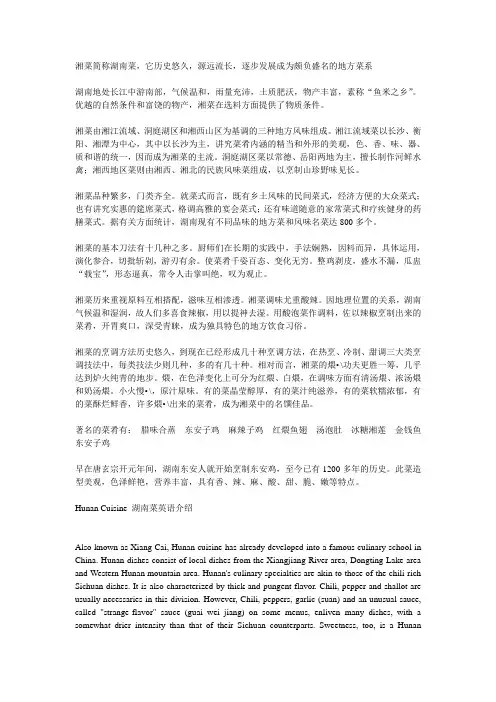
湘菜简称湖南菜,它历史悠久,源远流长,逐步发展成为颇负盛名的地方菜系湖南地处长江中游南部,气候温和,雨量充沛,土质肥沃,物产丰富,素称“鱼米之乡”。
优越的自然条件和富饶的物产,湘菜在选料方面提供了物质条件。
湘菜由湘江流域、洞庭湖区和湘西山区为基调的三种地方风味组成。
湘江流域菜以长沙、衡阳、湘潭为中心,其中以长沙为主,讲究菜肴内涵的精当和外形的美观,色、香、味、器、质和谐的统一,因而成为湘菜的主流。
洞庭湖区菜以常德、岳阳两地为主,擅长制作河鲜水禽;湘西地区菜则由湘西、湘北的民族风味菜组成,以烹制山珍野味见长。
湘菜品种繁多,门类齐全。
就菜式而言,既有乡土风味的民间菜式,经济方便的大众菜式;也有讲究实惠的筵席菜式,格调高雅的宴会菜式;还有味道随意的家常菜式和疗疾健身的药膳菜式。
据有关方面统计,湖南现有不同品味的地方菜和风味名菜达800多个。
湘菜的基本刀法有十几种之多。
厨师们在长期的实践中,手法娴熟,因料而异,具体运用,演化参合,切批斩剁,游刃有余。
使菜肴千姿百态、变化无穷。
整鸡剥皮,盛水不漏,瓜盅“载宝”,形态逼真,常令人击掌叫绝,叹为观止。
湘菜历来重视原料互相搭配,滋味互相渗透。
湘菜调味尤重酸辣。
因地理位置的关系,湖南气候温和湿润,故人们多喜食辣椒,用以提神去湿。
用酸泡菜作调料,佐以辣椒烹制出来的菜肴,开胃爽口,深受青睐,成为独具特色的地方饮食习俗。
湘菜的烹调方法历史悠久,到现在已经形成几十种烹调方法,在热烹、冷制、甜调三大类烹调技法中,每类技法少则几种,多的有几十种。
相对而言,湘菜的煨•\功夫更胜一筹,几乎达到炉火纯青的地步。
煨,在色泽变化上可分为红煨、白煨,在调味方面有清汤煨、浓汤煨和奶汤煨。
小火慢•\,原汁原味。
有的菜晶莹醇厚,有的菜汁纯滋养,有的菜软糯浓郁,有的菜酥烂鲜香,许多煨•\出来的菜肴,成为湘菜中的名馔佳品。
著名的菜肴有:腊味合蒸东安子鸡麻辣子鸡红煨鱼翅汤泡肚冰糖湘莲金钱鱼东安子鸡早在唐玄宗开元年间,湖南东安人就开始烹制东安鸡,至今已有1200多年的历史。

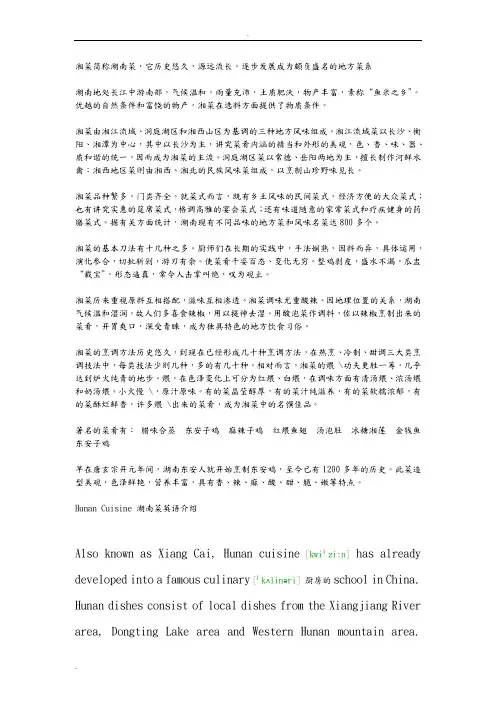
湘菜简称湖南菜,它历史悠久,源远流长,逐步发展成为颇负盛名的地方菜系湖南地处长江中游南部,气候温和,雨量充沛,土质肥沃,物产丰富,素称“鱼米之乡”。
优越的自然条件和富饶的物产,湘菜在选料方面提供了物质条件。
湘菜由湘江流域、洞庭湖区和湘西山区为基调的三种地方风味组成。
湘江流域菜以长沙、衡阳、湘潭为中心,其中以长沙为主,讲究菜肴内涵的精当和外形的美观,色、香、味、器、质和谐的统一,因而成为湘菜的主流。
洞庭湖区菜以常德、岳阳两地为主,擅长制作河鲜水禽;湘西地区菜则由湘西、湘北的民族风味菜组成,以烹制山珍野味见长。
湘菜品种繁多,门类齐全。
就菜式而言,既有乡土风味的民间菜式,经济方便的大众菜式;也有讲究实惠的筵席菜式,格调高雅的宴会菜式;还有味道随意的家常菜式和疗疾健身的药膳菜式。
据有关方面统计,湖南现有不同品味的地方菜和风味名菜达800多个。
湘菜的基本刀法有十几种之多。
厨师们在长期的实践中,手法娴熟,因料而异,具体运用,演化参合,切批斩剁,游刃有余。
使菜肴千姿百态、变化无穷。
整鸡剥皮,盛水不漏,瓜盅“载宝”,形态逼真,常令人击掌叫绝,叹为观止。
湘菜历来重视原料互相搭配,滋味互相渗透。
湘菜调味尤重酸辣。
因地理位置的关系,湖南气候温和湿润,故人们多喜食辣椒,用以提神去湿。
用酸泡菜作调料,佐以辣椒烹制出来的菜肴,开胃爽口,深受青睐,成为独具特色的地方饮食习俗。
湘菜的烹调方法历史悠久,到现在已经形成几十种烹调方法,在热烹、冷制、甜调三大类烹调技法中,每类技法少则几种,多的有几十种。
相对而言,湘菜的煨•\功夫更胜一筹,几乎达到炉火纯青的地步。
煨,在色泽变化上可分为红煨、白煨,在调味方面有清汤煨、浓汤煨和奶汤煨。
小火慢•\,原汁原味。
有的菜晶莹醇厚,有的菜汁纯滋养,有的菜软糯浓郁,有的菜酥烂鲜香,许多煨•\出来的菜肴,成为湘菜中的名馔佳品。
著名的菜肴有:腊味合蒸东安子鸡麻辣子鸡红煨鱼翅汤泡肚冰糖湘莲金钱鱼东安子鸡早在唐玄宗开元年间,湖南东安人就开始烹制东安鸡,至今已有1200多年的历史。
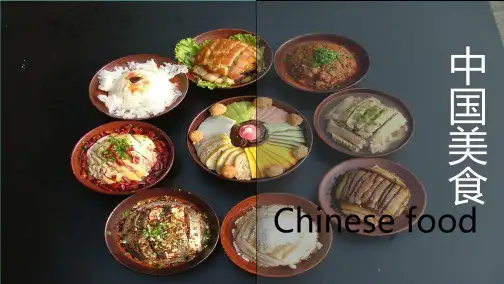

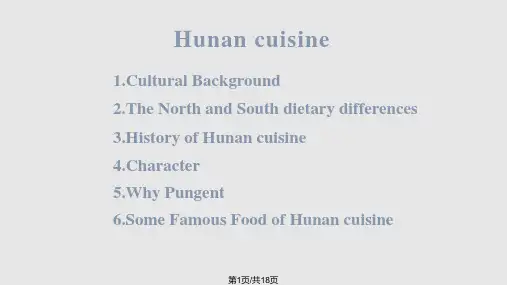

湖南菜英文介绍-CAL-FENGHAI-(2020YEAR-YICAI)_JINGBIAN湘菜简称湖南菜,它历史悠久,源远流长,逐步发展成为颇负盛名的地方菜系湖南地处长江中游南部,气候温和,雨量充沛,土质肥沃,物产丰富,素称“鱼米之乡”。
优越的自然条件和富饶的物产,湘菜在选料方面提供了物质条件。
湘菜由湘江流域、洞庭湖区和湘西山区为基调的三种地方风味组成。
湘江流域菜以长沙、衡阳、湘潭为中心,其中以长沙为主,讲究菜肴内涵的精当和外形的美观,色、香、味、器、质和谐的统一,因而成为湘菜的主流。
洞庭湖区菜以常德、岳阳两地为主,擅长制作河鲜水禽;湘西地区菜则由湘西、湘北的民族风味菜组成,以烹制山珍野味见长。
湘菜品种繁多,门类齐全。
就菜式而言,既有乡土风味的民间菜式,经济方便的大众菜式;也有讲究实惠的筵席菜式,格调高雅的宴会菜式;还有味道随意的家常菜式和疗疾健身的药膳菜式。
据有关方面统计,湖南现有不同品味的地方菜和风味名菜达800多个。
湘菜的基本刀法有十几种之多。
厨师们在长期的实践中,手法娴熟,因料而异,具体运用,演化参合,切批斩剁,游刃有余。
使菜肴千姿百态、变化无穷。
整鸡剥皮,盛水不漏,瓜盅“载宝”,形态逼真,常令人击掌叫绝,叹为观止。
湘菜历来重视原料互相搭配,滋味互相渗透。
湘菜调味尤重酸辣。
因地理位置的关系,湖南气候温和湿润,故人们多喜食辣椒,用以提神去湿。
用酸泡菜作调料,佐以辣椒烹制出来的菜肴,开胃爽口,深受青睐,成为独具特色的地方饮食习俗。
湘菜的烹调方法历史悠久,到现在已经形成几十种烹调方法,在热烹、冷制、甜调三大类烹调技法中,每类技法少则几种,多的有几十种。
相对而言,湘菜的煨•\功夫更胜一筹,几乎达到炉火纯青的地步。
煨,在色泽变化上可分为红煨、白煨,在调味方面有清汤煨、浓汤煨和奶汤煨。
小火慢•\,原汁原味。
有的菜晶莹醇厚,有的菜汁纯滋养,有的菜软糯浓郁,有的菜酥烂鲜香,许多煨•\出来的菜肴,成为湘菜中的名馔佳品。
